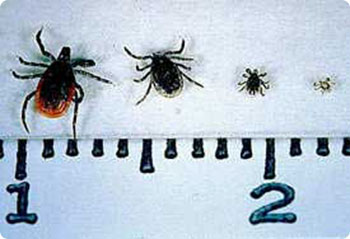What Is Lyme Disease?
Lyme disease is a bacterial infection that features a skin rash, swollen joints and flu-like symptoms. The number of reported cases in Vermont has steadily increased since 2005. Lyme disease cases have been reported from every county, although most cases occur in the southern and western regions of the state.
How Is Lyme Disease Transmitted?
 You get the disease from the bite of an infected black-legged tick, also known as a deer tick. The deer tick is smaller than the common dog tick and lives in wooded areas and adjacent grasslands. They feed on small and large animals like mice, shrews, birds, raccoons, opossums, deer and occasionally humans.
You get the disease from the bite of an infected black-legged tick, also known as a deer tick. The deer tick is smaller than the common dog tick and lives in wooded areas and adjacent grasslands. They feed on small and large animals like mice, shrews, birds, raccoons, opossums, deer and occasionally humans.
A tick bite is not painful. The tick is so small that its presence often goes unnoticed. In most cases the tick simply bites, draws blood for its nourishment and drops off.
If the tick happens to be infected with the spirochete bacterium (causative agent for Lyme disease), it may transmit the spirochetes during the feeding process.
In most cases, an infected tick must be attached for at least 36 hours in order to transmit Lyme disease. It is important to realize that a tick bite does not always result in Lyme disease. Prompt removal of ticks can prevent infection.
How Do I Remove a Tick?
The best way to remove ticks is to use small tweezers. Do not squeeze the tick's body. Grasp it where the mouth parts enter the skin and tug gently, but firmly, until it releases its hold on your skin. Wipe the bite area thoroughly with antiseptic.
Save the tick in a jar labeled with the date, the body location of the bite, and the place where you think you acquired the tick. Your doctor may find this information and the tick specimen helpful in diagnosis, in case a rash or other symptoms of Lyme disease subsequently appear.
What Are the Symptoms of Lyme Disease?
The symptoms of Lyme disease can vary because different parts of the body may be affected. The skin, joints, nerves or heart may be involved.
Early symptoms of Lyme disease typically appear within 3 to 30 days after a tick bite and include one or more of the following:
- Fatigue
- Chills and fever
- Muscle and joint pain
- Headache
- Swollen lymph nodes
- Erythema migrans (EM)
EM is a characteristic skin rash associated with Lyme disease. It occurs in up to 80% of people. The EM rash usually appears as an expanding rash at or near the site of the tick bite. The rash usually appears within seven to 14 days. The center of the rash may clear as it spreads, giving it the appearance of a bull's-eye. The rash may be warm, but it is usually not painful or itchy.
What Is the Treatment for Lyme Disease?
Appropriate treatment of Lyme disease with antibiotics almost always results in a full cure. While early treatment is best, most people diagnosed later in the course of illness can also be successfully treated.
How Do I Avoid Lyme Disease?
While there is no sure way to completely eliminate the chance of contracting Lyme disease, there are several preventative measures you can take:
- Wear long pants tucked into boots or socks and wear long-sleeved shirts buttoned at the cuff.
- Use tick repellents containing 0.5% permethrin or mosquito repellents containing 30% DEET.
- Check your clothing, skin and pets for ticks and remove them promptly.
What Is the Risk from Lyme Disease?
Be aware of Lyme disease, but don’t be so concerned that you stop enjoying the outdoors. The risk of developing the illness is minimal in most of Vermont and even if infection occurs the disease can be diagnosed and treated with antibiotics.
